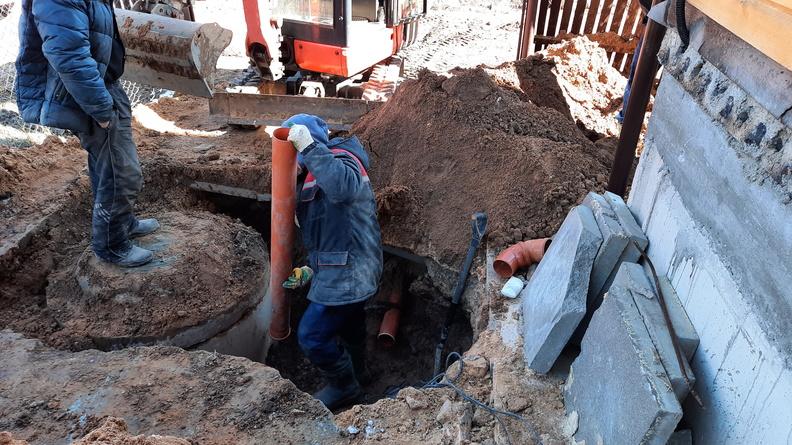Septic tank installation is a crucial step in providing efficient waste management for homes and businesses that are not connected to municipal sewer systems. Proper installation ensures that wastewater is treated and disposed of safely, protecting both the environment and public health.
Understanding Septic Systems
Before delving into the installation process, it's essential to understand how a septic system works. A septic system consists of three main components:
- Septic Tank: This is a buried, watertight container that collects and stores wastewater from your home. Inside the tank, solid waste settles to the bottom, while oils and grease float to the top. The remaining liquid wastewater flows out of the tank and into the drain field.
- Drain Field: Also known as a leach field, the drain field is a network of perforated pipes buried in trenches filled with gravel or other suitable material. The liquid wastewater from the septic tank is distributed evenly throughout the drain field, where it percolates through the soil, undergoes further treatment, and eventually reenters the groundwater.
- Soil: The soil beneath the drain field acts as a natural filter, removing harmful bacteria and other contaminants from the wastewater as it percolates through the ground.
Septic Tank Installation Process
Installing a septic tank is a complex process that requires careful planning, adherence to local regulations, and professional expertise. Here's an overview of the septic tank installation process:
- Site Assessment and Permitting
The first step is to conduct a thorough site assessment. This includes evaluating the soil type, water table level, and the site's suitability for a septic system.
Depending on your location, you may need to obtain permits and approvals from local health departments or environmental agencies. Compliance with zoning regulations and building codes is essential.
- Tank Selection
Choose an appropriately sized septic tank based on the estimated wastewater flow from your home or business. Tank capacity typically ranges from 1,000 to 2,500 gallons or more.
Consider the tank's material, with common options being concrete, fiberglass, or plastic. The choice depends on factors like budget, local regulations, and personal preferences.
- Excavation and Tank Placement
Excavate a hole for the septic tank based on the manufacturer's specifications and local regulations. This hole should be deep enough to accommodate the tank and allow for proper cover.
Ensure that the tank is level and properly positioned within the excavation site. Careful placement is critical to ensure long-term stability and performance.
- Inlet and Outlet Installation
Install inlet and outlet baffles within the septic tank to control the flow of wastewater. These baffles help prevent solid waste from entering the drain field and ensure even distribution of effluent.
Connect the building's wastewater plumbing to the septic tank's inlet.
- Backfilling
After the tank is securely in place and the inlet and outlet pipes are connected, backfill the excavation with suitable soil. This helps protect the tank and maintain its stability.
Compaction of the backfilled soil is crucial to prevent settling and damage to the tank.
- Leach Field Installation
Excavate trenches for the drain field pipes. These trenches should have the appropriate slope to facilitate the even distribution of effluent.
Lay perforated pipes in the trenches, ensuring that they are properly sloped to allow for the gravitational flow of wastewater.
Fill the trenches with gravel or other approved material to promote efficient wastewater distribution and filtration.
- Final Inspections and Testing
Before covering the drain field with soil, conduct final inspections to ensure that all components are correctly installed and comply with local regulations.
Perform percolation tests to determine the soil's ability to absorb and treat wastewater. Adjust
the drain field design if needed.
- Landscaping and Restoration
Once the septic system is in place and has passed all inspections, restore the landscaping to its original condition as much as possible.
Plant grass or other suitable vegetation over the drain field to help control erosion and maintain soil stability.
- Ongoing Maintenance
Regular septic tank maintenance is essential to ensure the system's longevity and effectiveness. This includes regular pumping of the tank to remove accumulated solids and inspecting the system for signs of damage or malfunction.
Septic tank installation is a meticulous process that requires careful planning, adherence to regulations, and professional expertise. When properly installed and maintained, septic systems provide efficient wastewater treatment and disposal for homes and businesses located in areas without access to municipal sewer systems. Investing in a well-designed and installed septic system is not only essential for the environment but also for the health and well-being of your community. If you're considering septic tank installation, always consult with a licensed professional to ensure the job is done correctly and responsibly.
Atlanta Septic Tank Pros has a lot of experience and they are all professionals in dealing with septic systems. You will be comforted to know that your septic system is in good hands. You can visit them at 400 West Peachtree St NW #4, Atlanta GA 30308. You can contact Atlanta Septic Tank Pros at (404) 998-8812 or visit their website at http://atlantaseptictankpros.com.
